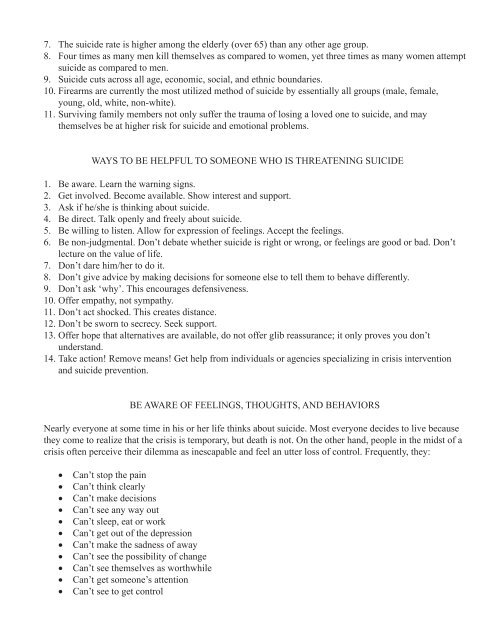Understanding and Helping the Suicidal Individual
Understanding and Helping the Suicidal Individual
Understanding and Helping the Suicidal Individual
Create successful ePaper yourself
Turn your PDF publications into a flip-book with our unique Google optimized e-Paper software.
7. The suicide rate is higher among <strong>the</strong> elderly (over 65) than any o<strong>the</strong>r age group.<br />
8. Four times as many men kill <strong>the</strong>mselves as compared to women, yet three times as many women attempt<br />
suicide as compared to men.<br />
9. Suicide cuts across all age, economic, social, <strong>and</strong> ethnic boundaries.<br />
10. Firearms are currently <strong>the</strong> most utilized method of suicide by essentially all groups (male, female,<br />
young, old, white, non-white).<br />
11. Surviving family members not only suffer <strong>the</strong> trauma of losing a loved one to suicide, <strong>and</strong> may<br />
<strong>the</strong>mselves be at higher risk for suicide <strong>and</strong> emotional problems.<br />
WAYS TO BE HELPFUL TO SOMEONE WHO IS THREATENING SUICIDE<br />
1. Be aware. Learn <strong>the</strong> warning signs.<br />
2. Get involved. Become available. Show interest <strong>and</strong> support.<br />
3. Ask if he/she is thinking about suicide.<br />
4. Be direct. Talk openly <strong>and</strong> freely about suicide.<br />
5. Be willing to listen. Allow for expression of feelings. Accept <strong>the</strong> feelings.<br />
6. Be non-judgmental. Don’t debate whe<strong>the</strong>r suicide is right or wrong, or feelings are good or bad. Don’t<br />
lecture on <strong>the</strong> value of life.<br />
7. Don’t dare him/her to do it.<br />
8. Don’t give advice by making decisions for someone else to tell <strong>the</strong>m to behave differently.<br />
9. Don’t ask ‘why’. This encourages defensiveness.<br />
10. Offer empathy, not sympathy.<br />
11. Don’t act shocked. This creates distance.<br />
12. Don’t be sworn to secrecy. Seek support.<br />
13. Offer hope that alternatives are available, do not offer glib reassurance; it only proves you don’t<br />
underst<strong>and</strong>.<br />
14. Take action! Remove means! Get help from individuals or agencies specializing in crisis intervention<br />
<strong>and</strong> suicide prevention.<br />
BE AWARE OF FEELINGS, THOUGHTS, AND BEHAVIORS<br />
Nearly everyone at some time in his or her life thinks about suicide. Most everyone decides to live because<br />
<strong>the</strong>y come to realize that <strong>the</strong> crisis is temporary, but death is not. On <strong>the</strong> o<strong>the</strong>r h<strong>and</strong>, people in <strong>the</strong> midst of a<br />
crisis often perceive <strong>the</strong>ir dilemma as inescapable <strong>and</strong> feel an utter loss of control. Frequently, <strong>the</strong>y:<br />
• Can’t stop <strong>the</strong> pain<br />
• Can’t think clearly<br />
• Can’t make decisions<br />
• Can’t see any way out<br />
• Can’t sleep, eat or work<br />
• Can’t get out of <strong>the</strong> depression<br />
• Can’t make <strong>the</strong> sadness of away<br />
• Can’t see <strong>the</strong> possibility of change<br />
• Can’t see <strong>the</strong>mselves as worthwhile<br />
• Can’t get someone’s attention<br />
• Can’t see to get control
















